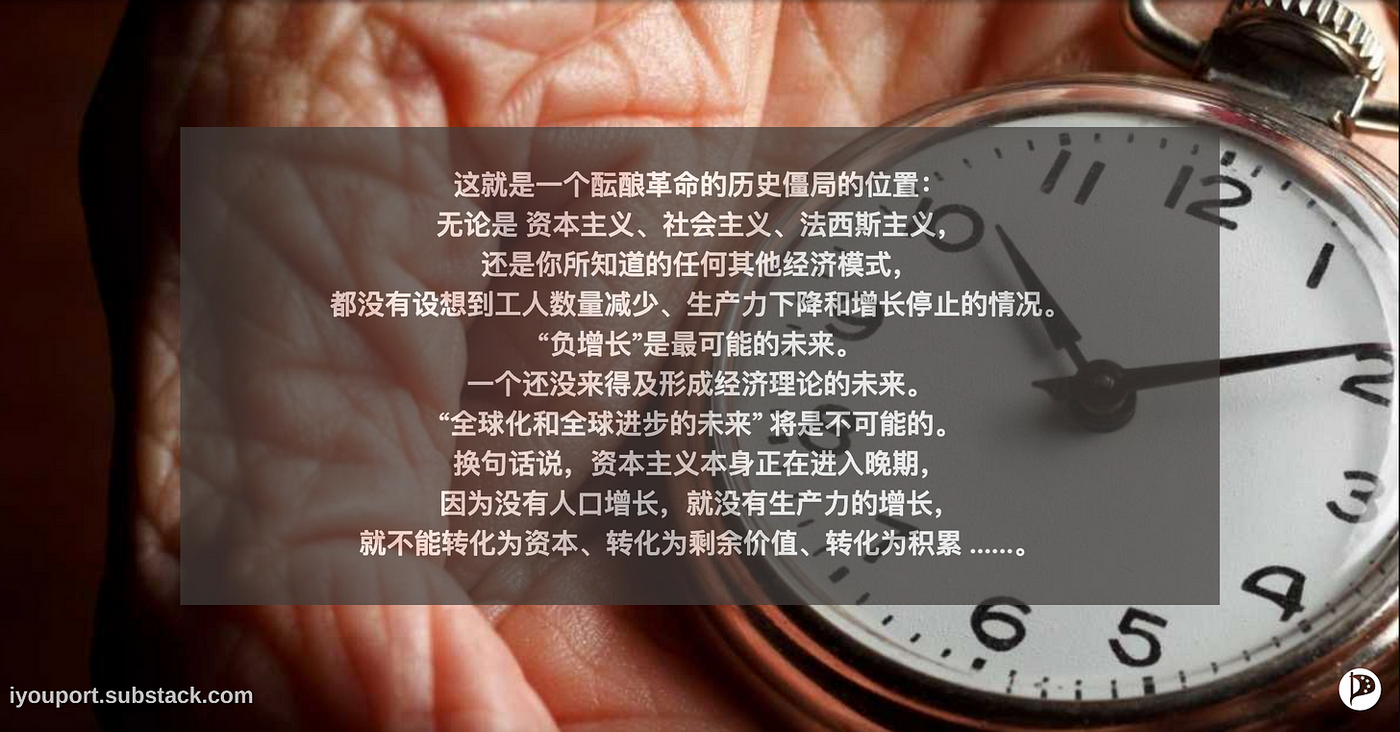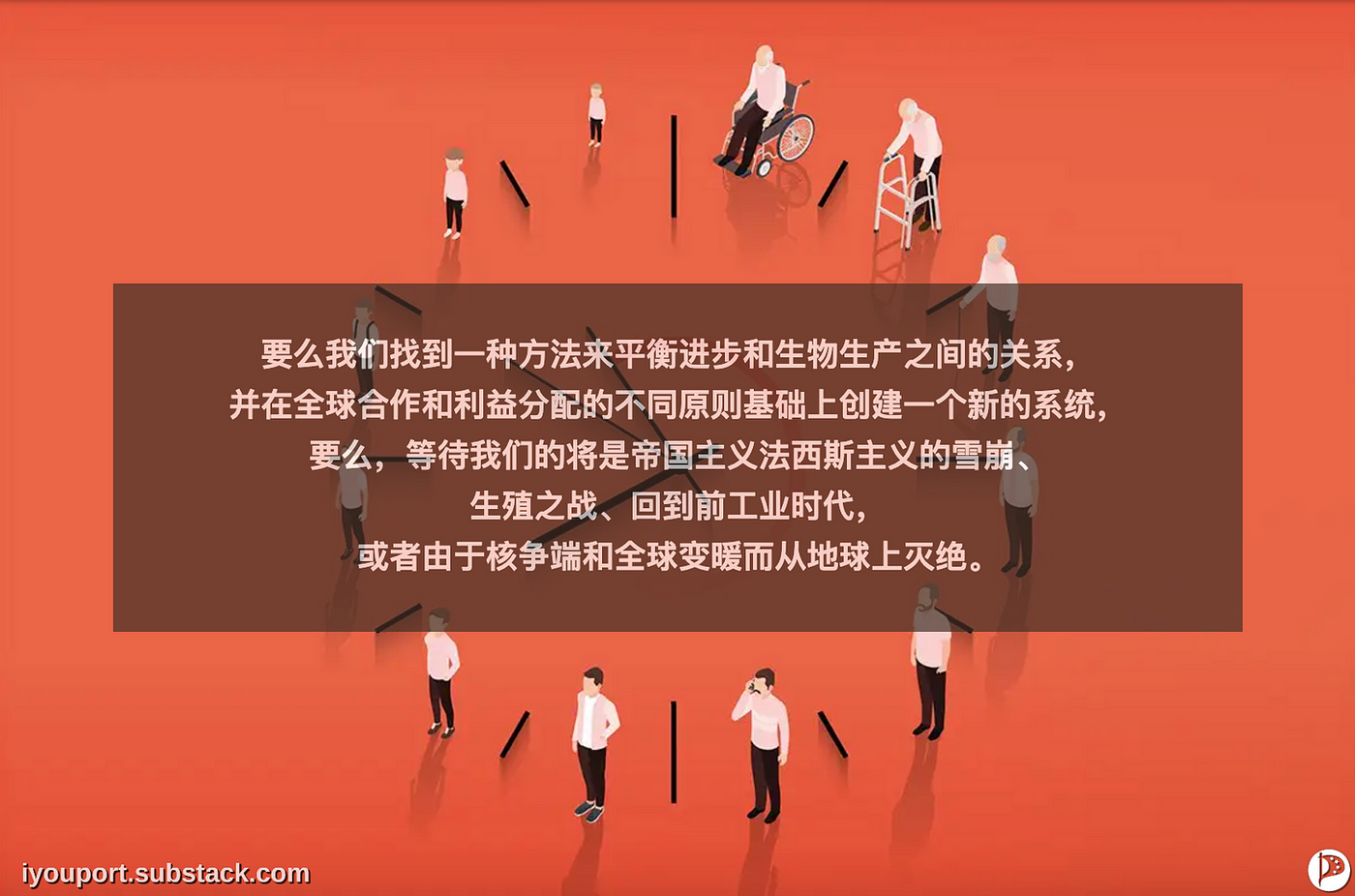
IYP 不是过眼云烟的新闻网站,我们提供实战能力,这里是值得您反复回看的档案室:iyouport.org
What does population mean?
Thank you readers for your contributions.

Recently, China's Xiaomi revealed its bionic robot CyberOne. The robot is 177 centimeters tall and weighs 52 kilograms, and it's been touted to the fullest. It is claimed that it “has high emotional intelligence, can perceive human emotions, has keen vision, and can reconstruct three-dimensional virtual reality of the real world”…
It's not yet known when CyberOne will go on sale. The estimated price is between RMB 600,000 and RMB 700,000.
This news was translated and disseminated in various languages, carrying the excitement of nationalism. In particular, it triggered some unrealistic discussions.

Some optimists don’t see their country’s aging population as a problem, saying “automation can solve everything.” This suggests that they understand neither the cost of such a solution nor the conditions required to deliver it, nor how capitalism works.
The modern world with all its technologies was made possible first by labor as the basis of progress, secondly by industrialization and thirdly by globalization - which allowed everyone to trade with everyone else and gain access to all markets , and enable production chains that were previously impossible.
The idea of making everything entirely yourself in a national economy might sound good until you realize that you simply don't have the resources for "everything" and if you try to produce something complex like a wireless headset, you'll be stuck in the supply chain Count until the 1200th step to see the headphones. Producing these things on a large scale and cheaply under the current economic model is only possible in the context of market specialization, global inequality, and globalization. The single-level world is over, and what follows is a multi-polar world.
Whether this is good or bad is still a philosophical question. But this is already happening , and it follows that tomorrow, when we live in a regional, nationalized, and in some cases deindustrialized world, everything will be less, everything will be different More expensive.
It costs $570 to produce an iPhone, but how much does an industrial robot cost? tens to hundreds of thousands.
Where do you get the aluminum, steel, plastic, Plexiglas, carbon fiber, synthetic rubber and other materials needed to build robots that can solve the problem of more and more old people, young people and less productive people?
For example, steel. The world's second largest steel production is concentrated in the cluster of Russia, Ukraine, and Belarus. If you conflict with the area, then your robot will have to be assembled from something else. Like aluminum? All right. However, the vast majority of production of this much less durable material also takes place in the same region (aluminum ranks third in the world in terms of production volume). Use war to “solve” the dictatorship problem? Then consider making a wooden robot...
In order to produce steel, you need energy to power the factory, and who has that energy? Who will control it?
This is how the politics of capitalist globalization works. In this case, it is impossible for Germany, for example, to just say: "You Putin is a bastard, murder is a crime, and we will not be friends with you." Because it’s not ideas, culture, ethics or morals that make the decisions here. The stuff that makes decisions is matter. Matter is the source of all language, movement, possibility. Existence determines consciousness. One person is attached to another person. The debate about the so-called "we will embrace robots and fly into a brighter future" is like a TikTok video posted by an Atlantean.
A more likely scenario is that robots become the next privilege for the well-fed classes in first world countries. In the Global South, where robots will function to clear out “surplus populations” and control starving slaves, these so-called “surplus populations” are a more affordable and accessible solution than robots. Chains and collars do not require Taiwanese microchips.
However, even if you eliminate all the "excess mouths", enslave a large group of people, and replace all those workers who want to eat and demand wages with robots, the question remains: who will buy what these robots will produce? iPhone? R2D2? Where do people get the money to buy them? ——Without workers, there are no consumers.
The age of consumerism is coming to an end. It is also no longer economically viable in terms of climate. No matter what any of us imagine now, there is unlikely to be any sign of robotization in the near future.
People who are wise enough should prepare for optimizing basic living standards and meeting basic needs, rather than preparing for the arrival of the steel Prometheus.


So, what exactly does population mean?
Progress affects demography: on the one hand, mortality rates fall, life expectancy increases, and the population grows; on the other, urbanization occurs and birth rates fall. What was free labor in the countryside—children—became an expensive burden in the city, and the private economic viability of childbearing was severely reduced. In other words, industrialization generated population growth, but it also changed the demographic structure of society: there were more old people (because people lived longer) and fewer young people (because city dwellers had fewer children).
Family structures were changing: women who had been the incubators of home cooks were moving to cities, gaining education and the opportunity to join the workforce needed for industrialization. The new conditions enabled them to make a living and protect themselves, and their busy work left them no time to have children; a women's rights movement emerged, a liberation that served the market and created a new identity for its members. When the need arises to double the size of the working class, "free women" emerge. Feminism helps factory work.
In 1700, the average British woman had 4.6 children. Just like German women in the 19th century. And Italian women in the 1900s, Korean women in the 1960s, or Chinese women in the 1970s. Today, fertility rates in all these countries have dropped to 1.8 children per woman, while societies require at least 2.1 children to reproduce.
Initially, a smaller number of children allowed for savings and the accumulation of capital. As a result, those societies that industrialized earlier accumulated more resources to invest in progress and maintained greater dynamism, even as their youth and productivity declined. However, this vitality is a temporary effect. The peak consumption occurs in the age group of 15 to 45 years old. This part is the driving force of the market economy. Its decline means less energy, less productivity, and a shortage of young people capable of producing and consuming.
The population is growing and the number of children is decreasing. Fewer children today means fewer young workers tomorrow and fewer skilled workers the day after tomorrow. A shortage of people capable of reproducing is a ticket to population collapse. Those countries that industrialize first will be the first to face this problem.
It's not just a shortage of workers. It’s about shortages of consumers and spending power, with more and more hungry mouths amid a collapsed economic system. We are the dinosaurs of the 21st century.
The 2020s are a turning point for China, Russia, Japan, Germany, Italy, South Korea, Ukraine, Canada, Malaysia, Taiwan, Romania, the Netherlands, Belgium and Austria. Their population will retire en masse, and there will be no one around to ensure a steady increase in reproduction. This will be the case in Brazil, Spain, Thailand, Poland, Australia, Cuba, Greece, Portugal, and Switzerland in the 2030s. Bangladesh, Chile, India, Vietnam, Indonesia, Mexico, Iran, Turkey, Morocco, Uzbekistan, Saudi Arabia and the Czech Republic must convince their 20-30-year-olds to have children today if they do not want to perish by the 2050s. immediately.
Fertility rates in Africa and Latin America appear to be normal, but only because these countries have reaped the benefits of industrialization without industrializing—namely, through globalization , which allowed them to import food and technology. Now, the United States, the guarantor of globalization, has neither the ability nor the need to continue to do so, so these regions are facing an era of war, disease, and hunger. Yes, they have a sea of young people; but the question is, how many of them will survive until tomorrow.
Either we find a way to balance the relationship between progress and biological production and create a new system based on different principles of global cooperation and distribution of benefits , or what awaits us will be an avalanche of imperialist fascism , reproductive war, return to pre-industrial times, or become extinct from the earth due to nuclear disputes and global warming .

[Note] A little explanation for the above: What is deglobalization? What does it mean?
Now, the term “deglobalization” has become a mantra you hear everywhere. But does everyone really know what it means?
In order to explain this concept, one should start with its opposite, namely: what is globalization? Globalization is the world order formed after World War II, which has proven to be the largest technological-industrial leap in human history. Of course, this does not negate the costs – global war and intervention, exploitation and inequality. But these are not the focus here.
Globalization is a bribe: the United States offers the world something it has never done before—the ability to trade with anyone. Until then, only empires with powerful fleets and colonial networks were capable of large-scale trade. The United States offered its navy to other nations as a guarantee of maritime security in exchange for... a political alliance against the Soviet Union. This deal was successful, and its success was written into the glorious history books - it determined the outcome of the Cold War: the collapse of the Soviet Union and became the fertilizer for the new world order - which began in the late 1980s/early 1990s and ends today. The golden age of global capitalism.
But if all goes well, why is there “deglobalization”? This is because,
1) The Soviet Union no longer exists and the old bribes have no meaning. The position of the United States today means that the purpose of bribery has been achieved.
2) Industrial progress caused by globalization has nourished global players, and today the United States does not have a fleet capable of controlling the world's oceans. Of course, it's still the most powerful fleet on Earth; great for projecting American power; but not for keeping all the world's waters under control and safe. And why should the US keep it when they themselves haven't joined globalization like Germany, let alone when they can be self-sufficient...
3) What happens to global progress? Global productivity growth and industrialization. This comes with urbanization: villagers go to the cities. They no longer have to work in the fields, they can go to factories, get a job in the service sector, sit in an office. At the same time, their children are free labor in rural settings and highly priced slaves in urban settings. As a result, urban dwellers have fewer children than rural dwellers, and over time this is reflected in demographics. This is why all developed societies are aging rapidly, their “raw material dependencies” are slow to urbanize, and fertility rates are declining over time. For example, the reason that this has not happened in some African countries is simply because they have not had time to industrialize... Given their dependence on imports, which in turn depend on a moribund global system, this means that millions of these young and educated Fertile people will face hunger, war, disease, and death.
This is where a historical impasse brews revolution: neither capitalism , nor socialism , nor fascism , nor any other economic model you know of, envisaged a situation in which the number of workers would decline, productivity would decline, and growth would cease. "Negative growth" is the most likely future. A future that has not yet had time to form an economic theory. A “future of globalization and global progress” will not be possible. In other words, capitalism itself is entering an advanced stage , because without population growth, there is no growth in productivity, which cannot be transformed into capital, into surplus value, into accumulation….
It is foreseeable that the world will be fragmented into regional trading systems built around local leaders. This is "deglobalization". A world made of patchwork. There is no overlord. There is no unified system. There are no common rules. Simply put: a world that struggles with fertility and geography . A multipolar world. A world where billions of people will be rendered “superfluous”. A world of hordes of hungry people, territorial overlords, slum cities and de-urbanized villages. In this world, everything will become less and everything will be more expensive.
This is where it’s worth thinking about, and where our political imagination needs to be applied. What is past is past. It's coming tomorrow. And it's up to us, each one of us, to fill it. ⭕️
#Ageing #Deglobalisation #Automation #Inequality #China #Imperialism #Nationalism
Like my work?
Don't forget to support or like, so I know you are with me..
Comment…